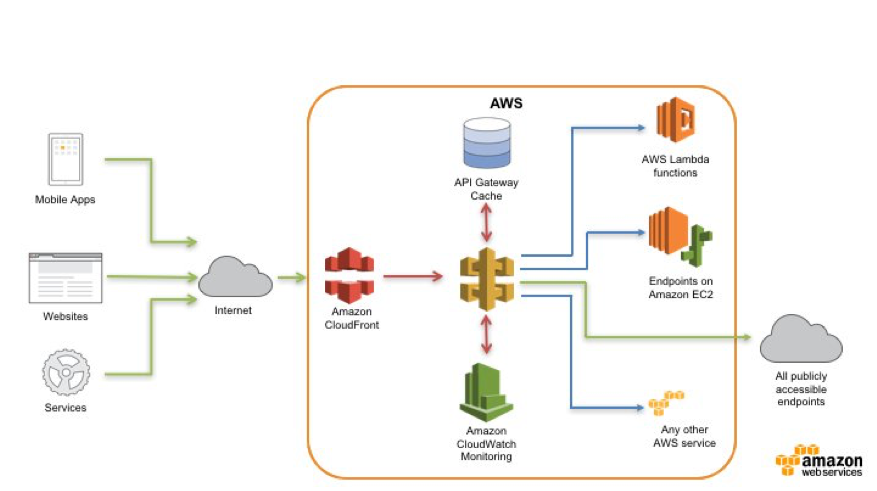AWS Compute Blog
Category: Networking & Content Delivery
Protecting your API using Amazon API Gateway and AWS WAF — Part 2
This post courtesy of Heitor Lessa, AWS Specialist Solutions Architect – Serverless In Part 1 of this blog, we described how to protect your API provided by Amazon API Gateway using AWS WAF. In this blog, we show how to use API keys between an Amazon CloudFront distribution and API Gateway to secure access to […]
Introducing Amazon API Gateway Private Endpoints
One of the biggest trends in application development today is the use of APIs to power the backend technologies supporting a product. Increasingly, the way mobile, IoT, web applications, or internal services talk to each other and to application frontends is using some API interface. Alongside this trend of building API-powered applications is the move […]
Protecting your API using Amazon API Gateway and AWS WAF — Part I
This post courtesy of Thiago Morais, AWS Solutions Architect When you build web applications or expose any data externally, you probably look for a platform where you can build highly scalable, secure, and robust REST APIs. As APIs are publicly exposed, there are a number of best practices for providing a secure mechanism to consumers […]
ICYMI: Serverless Q1 2018
This post courtesy of Paul Johnston, AWS Senior Developer Advocate – Serverless Welcome to the first edition of the AWS Serverless ICYMI (In case you missed it) quarterly recap! Every quarter we’ll share all of the most recent product launches, feature enhancements, blog posts, webinars, Twitch live streams, and other interesting things that you might have […]
Building an Immersive VR Streaming Solution on AWS
This post was contributed by: Konstantin WilmsSolutions Architect Shawn PrzybillaSolutions Architect Chad SchmutzerSolutions Architect With the explosion in virtual reality (VR) technologies over the past few years, we’ve had an increasing number of customers ask us for advice and best practices around deploying their VR-based products and service offerings on the AWS Cloud. It soon […]
Maintaining Transport Layer Security All the Way to Your Container: Using the Network Load Balancer with Amazon ECS
This post contributed by AWS Senior Cloud Infrastructure Architect Anabell St Vincent. Some systems or applications require Transport Layer Security (TLS) traffic from the client all the way through to the Docker container, without offloading or terminating certificates at a load balancer. Some highly time-sensitive services may require communication over TLS without any decryption and […]
How To Migrate Multi-Tier Environments Using The AWS Server Migration Service
This post courtesy of Shane Baldacchino, Solutions Architect at Amazon Web Services. Many customers ask for guidance on migrating end-to-end solutions running on virtual machines over to AWS. This post provides an overview of moving a common WordPress blog running on a virtualized platform to AWS, including re-pointing the DNS records associated to with the […]
Serverless @ re:Invent 2017
At re:Invent 2014, we announced AWS Lambda, what is now the center of the serverless platform at AWS, and helped ignite the trend of companies building serverless applications. This year, at re:Invent 2017, the topic of serverless was everywhere. We were incredibly excited to see the energy from everyone attending 7 workshops, 15 chalk talks, 20 […]
Longer Resource IDs in 2018 for Amazon EC2, Amazon EBS, and Amazon VPC
This post contributed by Laura Thomson, Senior Product Manager for Amazon EC2. As you start planning for the new year, I want to give you a heads up that Amazon EC2 is migrating to longer format, 17-character resource IDs. Instances and volumes currently already receive this ID format. Beginning in July 2018, all newly created […]
Event-Driven Computing with Amazon SNS and AWS Compute, Storage, Database, and Networking Services
Contributed by Otavio Ferreira, Manager, Software Development, AWS Messaging Like other developers around the world, you may be tackling increasingly complex business problems. A key success factor, in that case, is the ability to break down a large project scope into smaller, more manageable components. A service-oriented architecture guides you toward designing systems as a collection of […]








